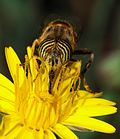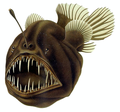Search results
Appearance
The page "Pollination mimicry" does not exist. You can create a draft and submit it for review or request that a redirect be created, but consider checking the search results below to see whether the topic is already covered.
- evolutionary biology, mimicry is an evolved resemblance between an organism and another object, often an organism of another species. Mimicry may evolve between...70 KB (7,695 words) - 18:57, 29 September 2024
- far less than mimicry in animals. It may provide protection against herbivory, or may deceptively encourage mutualists, like pollinators, to provide a...25 KB (2,930 words) - 18:30, 13 October 2024
- plants employing sexual mimicry, flowers mimic mating signals of their pollinator insects. These insects are attracted and pollinate the flowers through pseudocopulations...31 KB (4,004 words) - 15:37, 19 July 2024
- Flower (redirect from Pollinator attraction system)method of transport varies. Flowers can be pollinated by two mechanisms; cross-pollination and self-pollination. No mechanism is indisputably better than...103 KB (11,623 words) - 21:38, 26 September 2024
- carry out artificial pollination. A pollinator is different from a pollenizer, a plant that is a source of pollen for the pollination process. Plants fall...49 KB (5,594 words) - 23:52, 27 August 2024
- Aggressive mimicry is a form of mimicry in which predators, parasites, or parasitoids share similar signals, using a harmless model, allowing them to avoid...43 KB (5,027 words) - 14:02, 22 September 2024
- Pouyannian mimicry Pouyannian mimicry is a form of mimicry in plants that deceives an insect into attempting to copulate with a flower. The flower mimics...14 KB (1,263 words) - 18:43, 29 September 2024
- particular pollination they have sometimes created unique flowers with very strange pollination mechanisms. The species of these tribes are pollinated exclusively...39 KB (5,157 words) - 23:47, 26 September 2024
- Chemical mimicry (or molecular mimicry) is a type of biological mimicry involving the use of chemicals to dupe an operator. A chemical mimic dupes an operator...11 KB (1,398 words) - 23:53, 3 January 2024
- Wasp (redirect from Pollinator wasp)vast majority of wasps play no role in pollination, a few species can effectively transport pollen and pollinate several plant species. Since wasps generally...63 KB (6,795 words) - 23:12, 5 September 2024
- Eristalis tenax (section Mimicry)are an important but often neglected group of pollinators. They play a significant role in the pollination of agricultural biodiversity and the biodiversity...21 KB (2,687 words) - 06:20, 22 August 2024
- Hoverfly (section Pollination)mammals, though many species are mimics of stinging wasps and bees, a mimicry which may serve to ward off predators. Hoverfly hovering behavior is unlike...25 KB (2,712 words) - 03:50, 7 October 2024
- Pseudocopulation (category Mimicry)Leendert; Dodson, Calaway H. (1966). "Chapter 11: Mimicry and Deception". Orchid Flowers: Their Pollination and Evolution. University of Miami Press. pp. 129–141...6 KB (536 words) - 08:39, 22 August 2024
- Bee (section As commercial pollinators)specialized as pollination agents, with behavioral and physical modifications that specifically enhance pollination, and are the most efficient pollinating insects...119 KB (12,339 words) - 03:46, 28 September 2024
- Madagascar, and the Arabian Peninsula. Hydnora pollinates through brood-site mimicry. This is a method of pollination in which the plant emits a smell that is...7 KB (611 words) - 02:48, 27 August 2024
- Insect (section Pollination)transportation. The majority of pollination is by insects. Because insects usually receive benefit for the pollination in the form of energy rich nectar...134 KB (12,788 words) - 00:37, 7 October 2024
- an example of sexually deceptive pollination and floral mimicry, a highly selective and highly evolved plant–pollinator relationship. Ophrys apifera grows...21 KB (2,219 words) - 00:24, 13 September 2024
- insects exhibit protective mimicry of aggressive, stinging yellowjackets; in addition to numerous bees and wasps (Müllerian mimicry), the list includes some...16 KB (1,754 words) - 21:11, 12 October 2024
- Ambush predator (section Aggressive mimicry)opportunistic, and may be set by hiding in a burrow, by camouflage, by aggressive mimicry, or by the use of a trap (e.g. a web). The predator then uses a combination...30 KB (3,001 words) - 08:37, 15 September 2024
- opened blossoms, an unusual thing. Since this species is adapted to pollination by wasps, and avoided by other insects which have a respectful awe of
- frightened. Jeremy Clarkson: How do you get wheat to mate? Stephen Fry: Pollination. Jeremy Clarkson: Yes, well, how does that happen? Bill Bailey: You turn
- (1988). "Avian Predation on the Monarch Butterfly and Its Implications for Mimicry Theory". American Society of Naturalists. 131: S4–S6. doi:10.1086/284763


















